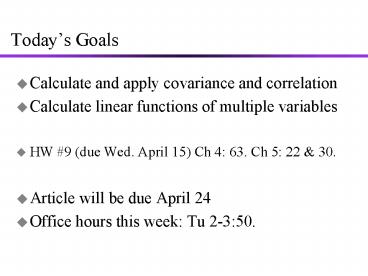Todays Goals - PowerPoint PPT Presentation
1 / 25
Title:
Todays Goals
Description:
Var(X Y) = Var(X) Var(Y) Cov(X,Y) Var(X-Y) = Var(X) Var(Y) Cov(X,Y) ... Load surveys indicate that the mean and var are the same on all floors. ... – PowerPoint PPT presentation
Number of Views:22
Avg rating:3.0/5.0
Title: Todays Goals
1
Todays Goals
- Calculate and apply covariance and correlation
- Calculate linear functions of multiple variables
- HW 9 (due Wed. April 15) Ch 4 63. Ch 5 22
30. - Article will be due April 24
- Office hours this week Tu 2-350.
2
Independence
- Two discrete R.V. are independent if
- p(x,y) p(x)p(y)
- Two continuous random variables X and Y are said
to be independent if for every pair of x and y
values, - f(x,y) fX(x) fY(y).
3
Expected Value
If X and Y are independent random variables,
then EXY EXEY.
4
Different degrees of covariance
5
Covariance
- Covariance is a measure of how related two
variables are specifically in a linear
relationship - Cov(X,Y) E(X-mx )(Y-my )
- short cut
- If X and Y are independent
6
Correlation
- The correlation Corr(X,Y) between two random
variables X and Y is - This number is always between -1 and 1
- If X and Y are independent, Corr(X,Y) 0
- However, the converse is not true
7
Correlation
Are these variables correlated? Are they
independent?
8
Example find correlation between HW and midterm
9
Example find correlation
- cov EXY EXEY
Sd .13 .24
10
The correlation coefficient between midterm
grades and HW scores is 0.14
11
Independence
- Two discrete R.V. are independent if
- p(x,y) p(x)p(y)
- Two continuous random variables X and Y are said
to be independent if for every pair of x and y
values, - f(x,y) fX(x) fY(y).
- If two RV are independent, then COVX,Y 0 and
EXY EXEY
12
Expected Value of a sum
- Regardless of covariance
- EXYEXEY
13
Variance of a sum or difference
- Var(XY) Var(X)Var(Y)Cov(X,Y)
- Var(X-Y) Var(X)Var(Y)Cov(X,Y)
- If X and Y are independent then
- Var(XY) Var(X)Var(Y)
- Var(X-Y) Var(X)Var(Y)
14
Are X and Y independent? T yes, Fno
p(0,0) .02 ? .2 .07 .014 p(0)p(0)
15
What is EXY?
EX 5.55 EY 8.55
16
What is EXY? EXY EXEY
EX 5.55 EY 8.55
17
True or False EMax(X,Y) 8.55
EX 5.55 EY 8.55
18
True or False EMax(X,Y) 8.55
EX 5.55 EY 8.55
Max is not a linear function, so the flaw of
averages applies
19
Correlation Proposition
- If a and c are either both positive or both
negative, Corr(aX b, cY d) Corr(X, Y) - For any two rvs X and Y,
20
Correlation Proposition
- If X and Y are independent, then
but does not imply independence. -
for some numbers a and b with
21
Expected Value and Variance of a sum of random
variables
22
Example building design
- The vertical load on the ground-floor columns of
an n-story building is the sum of the indivual
loads - Load surveys indicate that the mean and var are
the same on all floors. What is mean and variance
of Y?
23
Example building design
- The vertical load on the ground-floor columns of
an n-story building is the sum of the individual
loads - Load surveys indicate that the mean and var are
the same on all floors, so - EY nmx
24
Example building design
- We design the building to be safe, that is we
design it to take a load L so that P(YgtL) is very
small, say .001. - What happens if we assume independence between
the loads on different floors? What if the loads
are not independent?
25
Statistics and Statistical Inference































